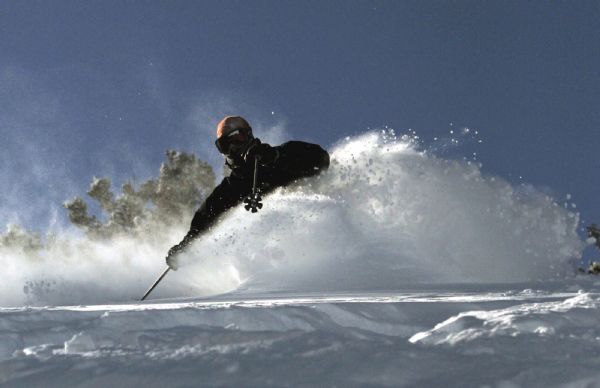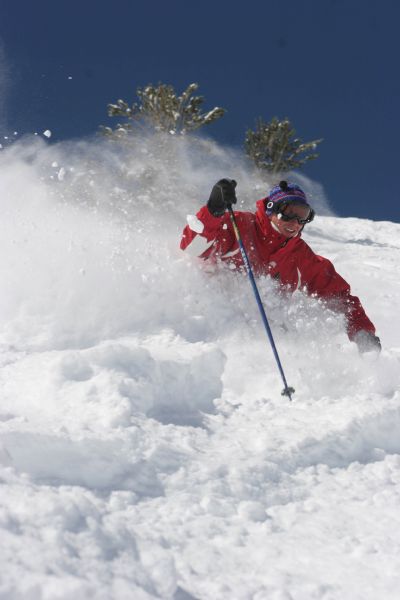This is an archived article that was published on sltrib.com in 2009, and information in the article may be outdated. It is provided only for personal research purposes and may not be reprinted.
Utah can't prove its boast of having "the greatest snow on Earth," but weather scientists, powder hounds and tourism officials can make the argument that most winters, the quantity and quality of the state's snow match any place in the world.
"We don't have the most or the driest but a unique blend of consistency and abundance that we think creates the greatest snow on Earth," said Ski Utah's Jessica Kunzer.
A case can be made that Utah offers skiers and boarders the best chance at a great snow day.
"Scientifically, we can't show anywhere has the greatest snow on Earth," said Jim Steenburgh, chairman of the University of Utah department of meteorology and an avid skier. "But the combination of the amount of snow we get, the quality and how it falls during storms is particularly special here. ... We get a lot of snow and it's good snow. Other places get drier snow, but not as much. Other places in the world get more snow, but it's a wetter snow than we see here."
Ski Utah compared Alta's long-term snow depth average with other popular Western resorts.
Alta averaged 547 inches of annual snowfall. Mt. Baker in Washington recorded the highest totals at 647 while Colorado resorts Arapahoe Basin averaged 350, Breckenridge 310, Steamboat 338, Telluride 309, and Winter Park 231. Squaw Valley, Calif., totaled 450.
As someone who attended graduate school in Seattle and skied often at Mt. Baker, Steenburgh loved that area.
"They get more snow on average than Alta, and I've skied there on great powder days," he said. "But they get a lot more heavier snow and are more susceptible to rain on snow events. It's more variable. They get some really good days, but other days that are far more challenging. ... I've been blown away by how consistently good skiing there is in Utah. Skiwise, there is an incredible climate."
Longtime Seattle freelance writer Peter Schroeder, who has skied all over the world, calls the question of best snow a good one. He said that if your definition of the best snow is the driest, then you ought to try skiing in New Mexico.
"The driest powder in the country is not in Utah but in New Mexico," he said. "The storms come across from California, and the Sonoran Desert sucks out all the moisture. ... The joke I often tell about New Mexico powder is that if you get caught in an avalanche, you can lick your way out and still die of thirst."
But does best powder equal best snow?
"The best deep-powder skiing is not found in the lightest snow but rather in snow with enough 'body' to provide good flotation for the running ski," said legendary avalanche expert and powder skier Ed LaChappelle in 1962.
And that is where Utah stakes its claim as having the greatest snow on Earth.
A typical storm that hits the Wasatch Mountains develops on the Pacific Ocean. When it hits the Sierra Nevada Mountains, it drops with about 10 percent to 12 percent moisture density. Then the clouds dry out as the storm continues east across the Great Basin into Utah, where the average snow density is 8.5 percent. By the time it reaches Colorado, the density has dropped to 6 percent.
The way the snow falls on the Wasatch is the key. Storms typically move in warmer and wetter but, after recirculating and occasionally interacting with the Great Salt Lake, they get colder and drier as they progress. This leaves a slightly denser excellent base on the bottom and fluffier, lighter snow on top.
"That's what you want for good bottomless powder skiing," said Steenburgh. "It allows the skis to float through the snow better. If you have high-density snow on top of low-density snow, the skis break through and stay submerged, making for more difficult skiing."
Then there is the matter of dendrites, something that William Alder, retired chief meteorologist for the National Weather Service's Salt Lake City office, talked about several years ago.
"The secret of Utah's unique and wonderful powder is the structure of the individual snow crystals," he said. "Under cold, relatively dry conditions, light crystal-type snowflakes called dendrites are produced. These snowflakes are thin and symmetrical in shape, and they float down through the cold atmosphere, accumulating like fluffy down or powder on Utah mountains."
Another big question about Wasatch Front snow involves the effect of the Great Salt Lake on the quality and quantity of snow.
"Lake-effect snow does tend to be a lighter snow crystal type than the type you see in the Sierras," said Randy Graham, science and operations officer for the National Weather Service's Salt Lake City office. "It definitely contributes on northwest flow events. It primes the air mass by contributing low-level moisture. It's a warm body of water that makes the air more unstable by making the low-level air a little warmer... but you have to have the right flow to contribute to that."
Steenburgh said El Niño and La Niña do not help us anticipate what kind of snow year we are going to have because they have the strongest impact on the southern Rockies and northern Rockies, but Utah sits right in the middle.
What's the bottom line?
Steenburgh said that, averaged over the ski season, it is probably true that it would be difficult to find better snow conditions than those in Utah.
But he said the best bet for lift-served powder anywhere in the world could be the Niseko ski resorts on Hokkaido Island in Japan during the months of December and January. That's winter monsoon season during which a persistent cold flow from Asia dumps incredible amounts of "sea-effect'" snow from the Sea of Japan. It's concentrated in those two months, as opposed to Utah, where the snowfall is consistent from month to month.
wharton@sltrib.com" Target="_BLANK">wharton@sltrib.com
The percent of moisture in snow determines its "dryness," which affects ski conditions. Experts say the quality of snow is a combination of how it falls, its moisture content and the amount. During most Wasatch Mountain snowstorms, heavier, wetter snow falls first and then, as it gets colder, lighter, drier snow falls. That creates a solid base and fluffy powder.
Snow moisture content
Sierras » 10 to 12 percent
Wasatch Mountains » 8.5 percent
Colorado Rocky Mountains » 6 percent
Average annual snowfall totals at Western resorts
Alta » 547 inches
Mt. Baker, Wash. » 647 inches
Arapahoe Basin, Colo. » 350 inches
Breckenridge, Colo. » 310 inches
Steamboat Springs, Colo. » 338 inches
Telluride, Colo. » 309 inches
Winter Park, Colo. » 231 inches
Squaw Valley, Calif. » 450 inches
Source: Ski Utah





